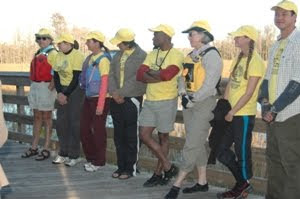(Public Comment to River of Grass Workshop, SFWMD, January 28, 2010)
RIVER OF GRASS Plenary & VALUING ECOSYSTEM SERVICES Break-out Session
Most everyone participating in the River of Grass Plenary Panel (Shannon Estonez, Tom Van Lent, Shelly Vana, and a few of the questioners) attributed significant value to restoring the missing link to revitalize the River of Grass, by taking a step in this direction in acquiring land owned by U.S. Sugar Corp, per the conference program: …provides an unprecedented opportunity to fully restore the Everglades. Underlining to beg the question: How much value?
The answer to this question was addressed in the Valuing Ecosystem Services breakout session, Ronnie Best moderator, with a power point presentation by Carl Shapiro: Ecosystem Services Valuation - Informing Land and Resource Management Decisions. (See handout for details)
Closing out the session, John Marshall proposed a notional River of Grass application using two factors: The first would be based on the first CERP Goal/Objective - Increasing the spatial extent of natural area. The second would be based on improving (enhancing) the state of the estuaries, from present degraded state; 50% degradation assumed. Costanza, et al, placed a value of wetlands at $7,924 per acre per year, and for estuaries, $9,240 per acre per year.
For the straight-forward KISS notional example of (1) a restoration and (2) enhancement, assume:
1. ROG restores X acres of some combination of natural wetlands including forested wetlands, flow-ways, and STA’s at $7,924 per acre per year; CERP life cycle is 40 years
2. Estuaries degraded at 50% have present value of $4,620 per acre per year (0.5 x $9240) and can be 90% restored to increase the value of the estuary acreage by $3696 per acre per year.
The notional ESV (KISS simplified) for each configuration is calculated by:
1. ESV (increased spatial extent) = X acres * $7924 per acre per year * 40 years = $Big1
2. ESV (improved estuary acres) = Y acres * $3696 per acre per year * 40 years = $Big 2
TOTAL VALUE OF CONFIGURATIONS (i to n) = SUM of BIG $ VALUE = $BIG
The Catskills watershed “model” was cited as an example. The tradeoff was $1 billion to restore the watershed, or $6 - $8 Billion water treatment plant to provide water to NYC. Cost avoidance, also a benefit, resulted in a cost benefit ratio of 6 to 8. Relates to CERP because restoring the natural system avoids a lot of salt water intrusion, reverse osmosis, desalinization plants etc.
Final notes: Avoid not valuing ecosystem services and thus placing zero value on them; this results in bad environmental decision making.
Does the resulting approach to benefit: cost analysis result in quintessential synthesis for decision making. TBD by implementation, implementers, and stakeholders.
1. Notional for a KISS example; actual application ought to be expanded per the NRC recommended Total Economic Valuation (TEV) approach. Another challenge is to avoid a valuation of zero to natural resources of high value. This is consistent with previous info presented to the Gov Board May 14, 2009.
2. Despite some controversy in peer reviewed literature, these economic valuations appear good enough for relative valuation of multiple configurations proposed in ROG plans; no need to reinvent the wheel. Costanza holds that the 1999 values are conservative. See http://www.uvm.edu/giee/publications/Nature_Paper.pdf
3. Of course given the TEV approach, all 17 of the ESV functions used in the Costanza et al, study should be considered as economic benefits, and compared to costs, to get to a benefit/cost ratio, and a single number synthesis.













